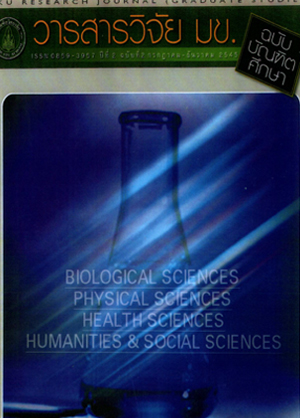A Construction of the Symbolic Divergent Production Test in Mathematics for Mattayomsuksa I Students (การสร้างแบบทดสอบวัดการคิดอเนกนัยด้านสัญลักษณ์ทางคณิตศาสตร์ สำหรับนักเรียน ชั้นมัธยมศึกษาปีที่ 1)
Keywords:
Divergent Production, Symbolic Units, Symbolic ClassesAbstract
The purposes of this study were to construct and obtain the quality of the Symbolic Divergent Production Test. The prototype test was constructed based on Guilfords Structure of Intellect Model. Its structure comprised of three dimensions which were the Operation: divergent thinking, the content: symbolic, and the products of 6 outcomes: Units, Classes, Relations, Systems, Transformation s and Implication. There was 6 subtests of 3 open -ended questions each. In each subtest represented a form of symbolic divergent production. Types of scoring were 3 following criteria : Fluency thinking, Flexibility thinking and Originality thinking . The research finding showed that: Every test item of 6 subtests obtained discrimination since the mean differences of high-score group and low -score group. The reliability of raters were more than 85% (0.9225). These indicated that the 6 subtests fit the theoretical Model of the stud y. Furthermore, each subtest confirmed that the test measured a single factor.
การวิจัยครั้งนี้มีวัตถุประสงค์เพื่อสร้างและหาคุณภาพของแบบทดสอบวัดการคิดอเนดนัยเชิงสัญลักษณ์คณิตศาสตร์ ซึ่งแบบทดสอบฉบับนี้สร้างตามแบบจำลองโครงสร้างทางสติปัญญาของกิลฟอร์ด มีโครงสร้างด้านวิธีการคิดเป็นการคิดเป็นการคิดอเนกนัย เนื้อหาการคิดเป็นแบบสัญลักษณ์ และผลการคิด 6 แบบคือ แบบหน่วย จำพวก ความสัมพันธ์ ระบบการแปลงรูปและกรประยุกต์ จำนวน 6 ฉบับๆ ละ 3 ข้อ แต่ละฉบับจะเป็นผลการคิด 1 แบบ โดยให้คะแนนเป็น 3 ด้านคือ ความคล่องในการคิด ความยืดหยุ่นในการคิดและความคิดริเริ่ม ผลการวิจัยพบว่า ข้อสอบแต่ละข้อในแบบทดสอบ สามารถจำแนกนักเรียนที่มีความคิดอเนกนัยเชิงสัญลักษณ์คณิตศาสตร์สูงและต่ำได้ ความเชื่อมั่นของการตรวจคะแนนได้ถึงร้อยละ 85 (0.9225) ขึ้นไป แสดงว่าแบบทดสอบวัดการคิดอเนกนัยด้านสัญลักษณ์ทางคณิตศาสตร์ที่ผู้วิจัยสร้างขึ้น มีความเชื่อมั่นในการตรวจคะแนนให้สูง และแบบทดสอบ 6 ฉบับ ในแต่ละด้านสามารถวัดองค์ประกอบตามโครงสร้างที่ผู้วิจัยกำหนดได้ และในแต่ละฉบับวัดองค์ประกอบเดียวกัน



